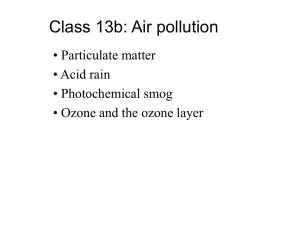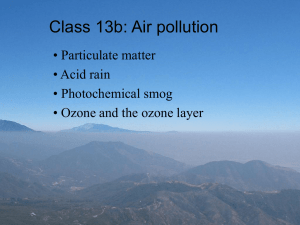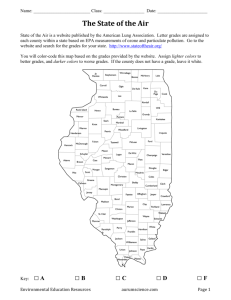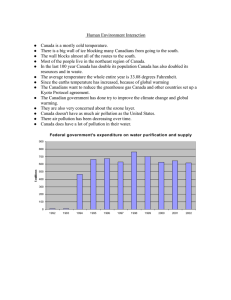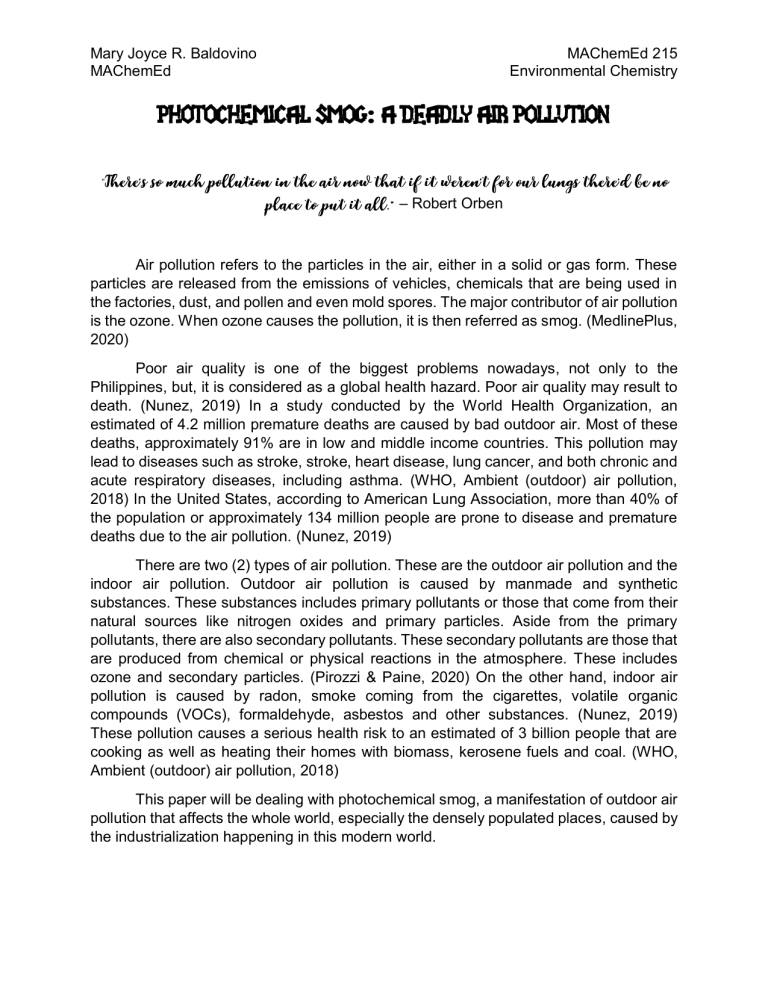
Mary Joyce R. Baldovino MAChemEd MAChemEd 215 Environmental Chemistry Photochemical Smog: a deadly Air pollution – Robert Orben Air pollution refers to the particles in the air, either in a solid or gas form. These particles are released from the emissions of vehicles, chemicals that are being used in the factories, dust, and pollen and even mold spores. The major contributor of air pollution is the ozone. When ozone causes the pollution, it is then referred as smog. (MedlinePlus, 2020) Poor air quality is one of the biggest problems nowadays, not only to the Philippines, but, it is considered as a global health hazard. Poor air quality may result to death. (Nunez, 2019) In a study conducted by the World Health Organization, an estimated of 4.2 million premature deaths are caused by bad outdoor air. Most of these deaths, approximately 91% are in low and middle income countries. This pollution may lead to diseases such as stroke, stroke, heart disease, lung cancer, and both chronic and acute respiratory diseases, including asthma. (WHO, Ambient (outdoor) air pollution, 2018) In the United States, according to American Lung Association, more than 40% of the population or approximately 134 million people are prone to disease and premature deaths due to the air pollution. (Nunez, 2019) There are two (2) types of air pollution. These are the outdoor air pollution and the indoor air pollution. Outdoor air pollution is caused by manmade and synthetic substances. These substances includes primary pollutants or those that come from their natural sources like nitrogen oxides and primary particles. Aside from the primary pollutants, there are also secondary pollutants. These secondary pollutants are those that are produced from chemical or physical reactions in the atmosphere. These includes ozone and secondary particles. (Pirozzi & Paine, 2020) On the other hand, indoor air pollution is caused by radon, smoke coming from the cigarettes, volatile organic compounds (VOCs), formaldehyde, asbestos and other substances. (Nunez, 2019) These pollution causes a serious health risk to an estimated of 3 billion people that are cooking as well as heating their homes with biomass, kerosene fuels and coal. (WHO, Ambient (outdoor) air pollution, 2018) This paper will be dealing with photochemical smog, a manifestation of outdoor air pollution that affects the whole world, especially the densely populated places, caused by the industrialization happening in this modern world. Mary Joyce R. Baldovino MAChemEd MAChemEd 215 Environmental Chemistry Photochemical Smog Photochemical smog is recognized as a major problem on air pollution throughout the world. It is the most important effect of the organic pollutants found in the atmosphere. It is characterized as a brown haze which is visible to the naked eye. This phenomenon is mostly occurring during morning and afternoon, especially to those places that are densely populated. Places abroad are experiencing this photochemical smog on a daily basis. These cities are Los Angeles, Sydney, Mexico City, Beijing and many others. (Afework, Hanania, Stenhouse, & Donev, 2018) Smog is a term that is derived from the words smoke and fog. This term is believed to be coined or used by H.A. Des Voeux in 1905. This word was used in order to describe the atmospheric conditions in many towns in Britain. In 1911, this word was then became popular by Des Voeux through his report on the Manchester Conference of the Smoke Abatement League of the Great Britain concerning on the more than 1,000 deaths caused by the “smoke-fog” in Glasgow and Edinburgh during the autumn season of 1909. (Tikkanen, 2019) Photochemical smog is caused by the chemical reaction of sunlight, nitrogen oxide and the organic compounds found in the atmosphere. The reaction happens when the sunlight reacts with the nitrogen oxide and 1 or more volatile organic compounds (VOCs). The nitrogen oxides (NO) and nitrogen dioxide (NO2) come from the exhaust from the cars, factory emissions and coal powerplants. On the other hand, the volatile organic compounds (VOCs) are those that are released from the use of gasoline, paints and cleaning solvents. When nitrogen dioxide (NO2) is then exposed into the ultraviolet radiation, it undergoes several reactions with the hydrocarbons. These reactions then lead to the production of the components of photochemical smog, which are ozone (O3), nitric acid, aldehydes, peroxyacyl nitrates (PANs) and the secondary pollutants. (Afework, Hanania, Stenhouse, & Donev, 2018) Composition of Photochemical Smog & its Health effects Tropospheric Ozone (O3) Tropospheric ozone is also known as the ground-level ozone. Ozone is the three (3) atom oxygen found in the upper atmosphere (stratosphere) and the lower atmosphere (troposphere). Ozone is a substance that we know to be beneficial. At stratospheric level, it is responsible for shielding the Earth towards the direct heat from the sun. This type of ozone is also known as the Ozone layer. On the other hand, the ozone found in the lower Mary Joyce R. Baldovino MAChemEd MAChemEd 215 Environmental Chemistry level of the earth, referred as the tropospheric ozone, is not beneficial to humans as well as the environment. This substance is produced as a result of the chemical reaction that happened between the oxides of nitrogen (NOx) and the volatile organic compounds (VOCs) and is not directly released into the air. This reaction occurs when the pollutants are released by various sources, like cars, power plants, industrial boilers, refineries and other sources which reacts chemically with sunlight. (EPA, Ground-level Ozone Pollution, 2020) It can bring negative effects to all the organisms living in the environment. It can rise to reach its unhealthy levels in urban areas during sunny days, however, its level can also rise during the months with colder temperature. Aside from this, ozone pollution are not only experienced by the people living in the cities having air pollution. It can also be experienced by people living in the rural areas for this substance, the ozone, can be transported to different places with long distances through the wind. (EPA, Ground-level Ozone Pollution, 2020) Breathing in of ozone particles are harmful to the health. Exposure to it may put children, elders, people working outside as well as those with asthma at risk. Ozone inhalation may result to chest pain, coughing, throat irritation, and airway inflammation. It may also lead to harming lung tissue and reduced lung function. Ozone exposure may also result to worsening of diseases such as asthma, bronchitis and emphysema. (EPA, Ground-level Ozone Pollution, 2020) Particulate Matter (PM) Particulate matter is a term used to define the mixture of the solid particles as well as the liquid droplets that are found in the air. These particles can be seen by the naked eye due to its large size like the dust, dirt, soot or smoke. On the other hand, some particles cannot be seen by the naked eyes so, an electron microscope is needed for its detection. (EPA, Particulate Matter (PM) Basics, 2020) Most of the particulate matter particles that form in the atmosphere are the result of chemical reactions between pollutants. The common particulate matter are the PM10 and PM2.5. The particulate matter referred as PM10 are those that are inhalable particles, having a diameter of 10 micrometers and even smaller. On the other hand, PM2.5 are fine particles that are also inhalable, having a diameter of 2.5 micrometers and smaller. (EPA, Particulate Matter (PM) Basics, 2020) In photochemical smog, PM2.5 is the most common constituent. Exposure to these particles is very harmful. Due to its size, it can get into the lungs, and in some cases, it may even get into the bloodstream. Several studies concluded that contact with these particles may lead to premature deaths (Maji, 2020) (Saini & Sharma, 2020) especially to those with lung or heart disease, nonfatal heart attacks, irregular heartbeat, people who have aggravated asthma, with decreased lung function and may Mary Joyce R. Baldovino MAChemEd MAChemEd 215 Environmental Chemistry also cause other respiratory problems like irritation of airways, coughing and breathing difficulty. People who are prone to these diseases are those that have pre-existing lung or heart disease, children and older adults. (EPA, Particulate Matter (PM) Pollution, 2020) Nitrogen Oxides (NOx) Nitrogen oxides refers to the substance that is a combination of nitric oxide (NO) and nitrogen dioxide (NO2). Nitric oxide (NO) is a colorless substance and is the one that produces nitrogen dioxide in the atmosphere through oxidation. Nitrogen dioxide, on the other hand, is a substance with odor and is acidic. It is highly corrosive gas, making it harmful to people’s health and the environment. These substances are produced in the environment from the natural sources, or can be emitted through the vehicles and other processes that involves burning of fuel. (Government, 2016) High levels of nitrogen dioxide can cause respiratory tract damage and is making people vulnerable to respiratory infections and diseases as well as asthma. Long term exposure to it may also lead to chronic lung disease. (Government, 2016) Volatile Organic Compounds (VOCs) Volatile organic compounds (VOCs) are characterized of having a property of high vapor pressure and low water solubility. Most of these substances are man-made chemicals that are being used and released from the paint production, pharmaceuticals as well as in refrigerants. Aside from these sources, VOCs are also used as a component of petroleum fuels, hydraulic fluids, paint thinners, and dry cleaning agents. VOCs are also a common ground-water contaminant, aside from being an air pollutant. (EPA, What are volatile organic compounds (VOCs)?, 2019) Volatile organic compounds (VOCs) contain various chemicals that may cause irritation of the eyes, nose and throat, shortness of breathing, fatigue, headache, nausea, dizziness and skin problems. Exposure to higher concentrations of VOCs may lead to lung irritation as well as damage of some internal organs like liver, kidney and even the central nervous system. (HealthLinkBC, 2018) Aside from this, VOCs are also suspected to cause cancer to humans (HealthLinkBC, 2018, Association, 2020) due to the fact that some VOCs contain formaldehyde and benzene which are human carcinogens. (Lab, 2020) Volatile organic compounds are also found to be harmful to pregnant women. It was found out that VOCs affect the unborn babies resulting to low birth weight (Chang, et al., 2017), birth defects (Boyle, et al., 2016) and premature births (Chang, et al., 2017) Mary Joyce R. Baldovino MAChemEd MAChemEd 215 Environmental Chemistry Peroxyacetyl Nitrates (PAN) Peroxyacetyl nitrate [CH3C(O)OONO2] is an important composition of the photochemical smog. This substance is present in the troposphere. At cold temperatures, it is very stable, while it decomposes during warm temperature in order to produce or release NOx, in which, it is important in ozone formation. Peroxyacetyl nitrate may lead to eye irritation, and is also known to be phytotoxins and bacterial mutagens. (Singh, 2015) Addressing the Problem Air pollution, particularly the photochemical smog is becoming a major concern all throughout the world. It became a global concern for its effect on the environment as well as the people living in the places wherein this type of pollution occurs. With this, several projects are being done as well as laws are formulated and being enforced that can help to solve the problems regarding the pollution. Clean Air Act In the United States, the Clean Air Act is a federal law in which it aims to protect the citizens’ health as well as the environment from the harmful effects of air pollution. Under this law, the Environmental Protection Agency (EPA) is tasked to control or regulate the pollutant emissions which puts the health and welfare of the people in danger. The important achievements of this act is the lowering the level of the ground-level ozone which is one of the component of the photochemical smog by more than 25% as well as reducing the nitrogen dioxide in the atmosphere by 46% since its implementation in the 1980. (Scientists, 2012) Aside from the laws and regulations being implemented, people can also do something to avoid being affected by the pollution as well as reducing their contribution to this problem. In addition to abiding the law, people can do something about the photochemical smog. The following actions are helpful in reducing the photochemical smog: 1. Drive less. It can lessen the gasses being emitted into the atmosphere that may lead to the formation of photochemical smog. Walking, biking carpool or riding public transportation can be done if possible. 2. Take care of the cars. Get regular tune-ups, change oil on the scheduled date and time as well as inflate the tires on its right level. With this, it can improve gas mileage as well as reduction in emissions. Mary Joyce R. Baldovino MAChemEd MAChemEd 215 Environmental Chemistry 3. It is better to fuel up during night or early morning. Fueling up during these cooler hours of the day prevents the gas fumes to heat up as well as produce ozone. 4. Avoid using or buying products containing or releasing high levels of volatile organic compounds (VOCs). 5. Prefer using electric appliances rather than gas-powered yard equipment. (National Geographic, 2011) According to an article posted the U.S. Embassy to the Philippines, there are eight (8) tips that a person must do in order to reduce the exposure to the air pollution. The tips are: 1. Avoid travelling during the rush hours or the busiest times of the day in places like Metro Manila. Metro Manila is one of the places in which traffic jams are almost normal every day. Due to this traffic congestion, greater concentration of particulate matter (PM) are being produced because of the high number of vehicles as well as its rapid stopping and starting behavior. 2. Avoid travelling in a prolonged amount of time along the major road. If possible, when driving or travelling, take a road with a distance from those major roadways. Traveling on the busy roads is almost a part of everyday life in Metro Manila. Since there are traffic jams, there will be more concentration of particulate matter in the air. According to a research, particulate matter (PM) exposure decreases when there is distance from major roadways, especially in those places having high numbers of diesel engine vehicles. (WHO, Review of evidence on health aspects of air pollution – REVIHAAP Project: Technical Report, 2013) 3. When driving, settle in using cleaner “Euro V” fuel. This type of fuel is easy to find since it is offered with almost all of the gas stations all throughout the Metro Manila. By using this fuel is equivalent to burning cleaner fuel. Burning cleaner fuel leads to a reduction on the tailpipe emissions which are harmful. For the cars that is powered by gasoline, the use of Euro V instead of Euro IV gasoline can lessen the harmful emissions of Carbon Monoxide (CO) by up to 74% and Nitrogen Oxides (NOx) by up to 31%. For those that are using older diesels, Euro V diesel may lead to a reduction of Carbon Monoxide (CO) by up to 38% as well as the particulate matter emissions by up to 20%, compared to the use of Euro IV diesel. (Wangwongwatana, 2017) 4. Mask is a must. Wear a mask on days having poor air quality and when travelling on the major roadways. Using the right mask can filter 95 out of 99% of the small particles that we breathe in. Mary Joyce R. Baldovino MAChemEd MAChemEd 215 Environmental Chemistry 5. Use air filter in your home and in any places wherein you are spending a lot of time when you are indoors. Effective indoor air filters are those that have high rates of circulation. 6. Monitor as well as limit the exposure to smoke and other harmful toxins and pollutants, either directly and indirectly. According to the World Health Organization (WHO), each year, there are over 7 million deaths due to the direct use of tobacco while there are around 1.2 million death that are the result of nonsmokers being exposed to second-hand smoke. (WHO, Tobacco, 2020) 7. Cook using cleaner stove. Using charcoal or wood in cooking leads to the release of dangerous levels of particulate matter (PM), gases and other toxins into the air. This can be more harmful if this is used indoors due to the fact that air cannot circulate. According to the estimation of the World Health Organization, there are almost 4 million people worldwide that die prematurely due to the indoor air pollution which is related to the inefficient cooking practices every year. (WHO, Household Air Pollution and Health, 2018) 8. Reduce burning of wastes. Open air burning of waste and other materials may lead to the release of fine particulate matter (PM). These substance is responsible for damaging the lungs and is also associated with other respiratory and cardiovascular diseases. Aside from releasing particulate matter into the air, burning or wastes may also lead to the production of carbon monoxide, dioxin, formaldehydes, heavy metals and the volatile organic compounds or chemicals (VOCs) which are harmful to everyone’s health and are also constituents of photochemical smog. (EPA, Outdoor Air - Industry, Business, and Home: Backyard Trash Burning - Additional Information, 2016) Conclusion Air pollution, like the photochemical smog is very dangerous to all human beings. It is a phenomenon that is caused mostly through the phenomenon that is naturally occurring in the planet as well as the contribution of the people. People must be aware of their own surroundings, be informed of what is happening especially if it may concern their health. Information is not impossible this time due to the vast knowledge that can be read in the internet. So, as responsible citizens, it must be the people’s duty to research if what they are doing is right and what can they do to reduce the effects of the pollution. There is nothing wrong with adapting to the changes happening in the world. There is also nothing wrong with modernization and industrialization happening around the world. However, people must always be aware of their actions. They must open their minds and eyes that in every action that they will take, especially if it concerns the environment, they are also the ones that will also suffer from it. In the case of this photochemical smog pollution, as people, we contribute to the formation of it, but we can Mary Joyce R. Baldovino MAChemEd MAChemEd 215 Environmental Chemistry still do something to reduce its effects. As the ones that will suffer from it, we must take part of the action, be part of the solution instead of being part of the pollution. Mary Joyce R. Baldovino MAChemEd MAChemEd 215 Environmental Chemistry References Afework, B., Hanania, J., Stenhouse, K., & Donev, J. (2018, September 3). Energy Education Photochemical Smog. Retrieved from University of Calgary: https://energyeducation.ca/encyclopedia/Photochemical_smog#:~:text=Photochemical%20smo g%20is%20a%20type,in%20densely%20populated%2C%20warm%20cities. Association, A. L. (2020, February 12). Volatile Organic Compounds. Retrieved from American Lung Association: https://www.lung.org/clean-air/at-home/indoor-air-pollutants/volatile-organiccompounds Boyle, E. B., Viet, S. M., Wright, D. J., Merrill, L. S., Alwis, K., Blount, B. C., . . . Dellarco, M. (2016). Assessment of Exposure to VOCs among Pregnant Women in the National Children's Study. International Journal of Environmental Research and Public Health. Chang, M., Park, H., Ha, M., Hong, Y.-C., Lim, Y.-H., Kim, Y., . . . Ha, E.-H. (2017). The Effect of Prenatal TVOC Exposure on Birth and Infantile Weight: the Mothers and Children's Environmental Health Study. Pediatric Research. EPA. (2016, February 21). Outdoor Air - Industry, Business, and Home: Backyard Trash Burning Additional Information. Retrieved from United States Environmental Protection Agency: https://archive.epa.gov/airquality/community/web/html/barrelburn_addl_info.html EPA. (2019, August 1). What are volatile organic compounds (VOCs)? Retrieved from United States Environmental Protection Agency: https://www.epa.gov/indoor-air-quality-iaq/what-arevolatile-organic-compounds-vocs EPA. (2020, September 10). Ground-level Ozone Pollution. Retrieved from United States Environmental Protection Agency: https://www.epa.gov/ground-level-ozone-pollution/ground-level-ozonebasics EPA. (2020, October 1). Particulate Matter (PM) Basics. Retrieved from United States Environmental Protection Agency: https://www.epa.gov/pm-pollution/particulate-matter-pm-basics EPA. (2020, April 13). Particulate Matter (PM) Pollution. Retrieved from United States Environmental Protection Agency: https://www.epa.gov/pm-pollution/health-and-environmental-effectsparticulate-matterpm#:~:text=Numerous%20scientific%20studies%20have%20linked,irregular%20heartbeat Geographic, N. (2011). Smog. Retrieved from National Geographic: https://www.nationalgeographic.org/encyclopedia/smog/ Government, Q. (2016, September 27). Nitrogen Oxides. Retrieved from Queensland Government: https://www.qld.gov.au/environment/pollution/monitoring/air/airpollution/pollutants/nitrogen-oxides HealthLinkBC. (2018, June). Indoor Air Quality: Volatile Organic Compounds (VOCs). Retrieved from HealthLinkBC: https://www.healthlinkbc.ca/healthlinkbc-files/air-qualityVOCs#:~:text=VOCs%20include%20a%20variety%20of,kidney%2C%20or%20central%20nervous %20system. Mary Joyce R. Baldovino MAChemEd MAChemEd 215 Environmental Chemistry Lab, B. (2020). VOCs and Cancer. Retrieved from Berkeley Lab: https://iaqscience.lbl.gov/voccancer#:~:text=A%20number%20of%20the%20VOCs,2%2C%2062%2C%2063%5D. Maji, K. J. (2020). Substantial changes in PM2.5 pollution and corresponding premature deaths across China during 2015–2019: A model prospective. ScienceDirect. MedlinePlus. (2020, September 29). Indoor Air Pollution. Retrieved from U.S. National Library of Medicine: https://medlineplus.gov/indoorairpollution.html Nunez, C. (2019, February 4). Climate 101: Air Pollution. Retrieved from National Geographic: https://www.nationalgeographic.com/environment/global-warming/pollution/ Pirozzi, C., & Paine, R. (2020). Indoor and Outdoor Air Pollution. Retrieved from PulmonaryAdvisor: https://www.pulmonologyadvisor.com/home/decision-support-in-medicine/pulmonarymedicine/indoor-and-outdoor-air-pollution/ Saini, P., & Sharma, M. (2020). Cause and Age-specific premature mortality attributable to PM 2.5 Exposure: An analysis for Million-Plus Indian cities. National Library of Medicine. Scientists, U. o. (2012, February 1). The Clean Air Act. Retrieved from Union of Concerned Scientists: https://www.ucsusa.org/resources/clean-air-act Singh, H. (2015). Tropospheric Chemistry and Composition: Peroxyacetyl Nitrate . ScienceDirect, 251254. Tikkanen, A. (2019, December 17). Smog. Retrieved from Britannica: https://www.britannica.com/science/smog#ref16459 Wangwongwatana, D. S. (2017). Implementing Vehicle Emission Standards and Equivalent Fuel Quality and the Case of Thailand’s Roadmap to Euro 6/VI. Retrieved from Clean Air Asia: https://cleanairasia.org/wp-content/uploads/2018/05/Dr-Supat-WangwongwatanaImplementing-Vehicle-Emission-Standards-and-Equivalent-Fuel-Quality-and-the-Case-ofThailand%E2%80%99s-Roadmap-to-Euro-6-VI.pdf WHO. (2013). Review of evidence on health aspects of air pollution – REVIHAAP Project: Technical Report. Retrieved from World Health Organization: https://www.ncbi.nlm.nih.gov/books/NBK361807/ WHO. (2018, May 2). Ambient (outdoor) air pollution. Retrieved from World Health Organization: https://www.who.int/en/news-room/fact-sheets/detail/ambient-(outdoor)-air-quality-andhealth WHO. (2018, May 8). Household Air Pollution and Health. Retrieved from World Health Organization: https://www.who.int/news-room/fact-sheets/detail/household-air-pollution-and-health WHO. (2020, May 27). Tobacco. Retrieved from World Health Organization: https://www.who.int/newsroom/fact-sheets/detail/tobacco

